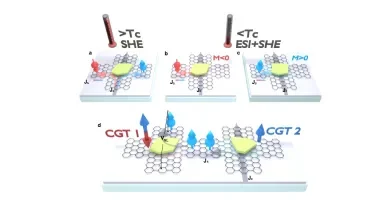The first-ever 2D spintronics device constructed entirely from proximitized structures
Researchers from CIC nanoGUNE, in collaboration with international partners, have achieved the first seamless 2D spintronics device made entirely from proximitized structures. They report a two-dimensional graphene spin valve that is enabled by proximity to the van der Waals magnet Cr2Ge2Te6. Published in Nature Electronics, this innovative work lays the groundwork for a new research field and advancements in spintronics technology.

The field of spintronics has evolved significantly since the pioneering discoveries of spin injection and giant magnetoresistance in the 1980s, which relied on spin-polarized electron injection from a ferromagnetic metal to a normal metal. These groundbreaking achievements earned Albert Fert and Peter Grünberg the 2007 Nobel Prize in Physics, laying the foundation for ongoing research into complex material combinations and interface optimization techniques.
Pristine graphene is potentially an ideal medium to transport spin information. Proximity effects, where a neighboring material is used to alter the properties of a material in adjacent (or proximitized) regions, can also be used in graphene to generate and detect spins by acquiring spin-orbit coupling or magnetic exchange coupling. However, the development of seamless spintronic devices that are based uniquely on proximity effects remains challenging.
The Nanodevices group in CIC nanoGUNE, San Sebastian, in collaboration with Laboratoire Albert Fert in France, UPV/EHU and Donostia International Physics Center (DIPC) in San Sebastián, IMEC in Belgium and Beihang University in China, achieved the first-ever realization of a seamless 2D spintronics device constructed entirely from proximitized structures, which allows for spin manipulation and transport to occur within the 2D plane. Specifically, “we created a lateral spin valve made of a single piece of graphene, which is locally functionalized by proximity using the van der Waals magnetic insulator Cr2Ge2Te6. The central component of this all-2D spin valve, proximitized graphene, is observed to present the coexistence of spin-orbit proximity and magnetic proximity”, explained Haozhe Yang, first author of the research carried out during his postdoc at CIC nanoGUNE, and currently working as associate professor at Beihang Unversity. Furthermore, “the technological performance of the proximitized device, which is made using only the proximity effect, is poised to capture the attention of a wide range of researchers in the electronics and spintronics community”, adds Ikerbasque Research Professor Fèlix Casanova, co-leader of the Nanodevices group at nanoGUNE and leader of the study.
This new structure introduces strong evidence for the feasibility of using the proximity effect to build essential electronic devices and has the potential to pave the way for "proximitronic" devices. This work enables the elimination of interfaces in devices, thereby creating a seamless junction for decreasing the loss of spins. This simple yet innovative all-proximitized spintronic device will inspire further research aimed at enhancing the understanding and application of the proximity effect. Given its fundamental significance and potential applications, the proximitized device may lay the foundation for an entirely new research field.
References:
Yang, H., Gobbi, M., Herling, F. et al.
A seamless graphene spin valve based on proximity to van der Waals magnet Cr2Ge2Te6.
Nat Electron (2024).
https://doi.org/10.1038/s41928-024-01267-0
